Joshua Tree National Park is a unique place. It’s one of the most popular natural parks in California and attracts both tourists and locals alike to explore its beautiful trails, rock formations, and canyons. Joshua Tree offers something for everyone with some easy hiking trails that are perfect for families who want to get up close and personal with nature, or long, challenging hikes that will test even the most experienced hiker! So what are you waiting for? Read this guide before you pack up your gear (and maybe a few sandwiches) and head out!
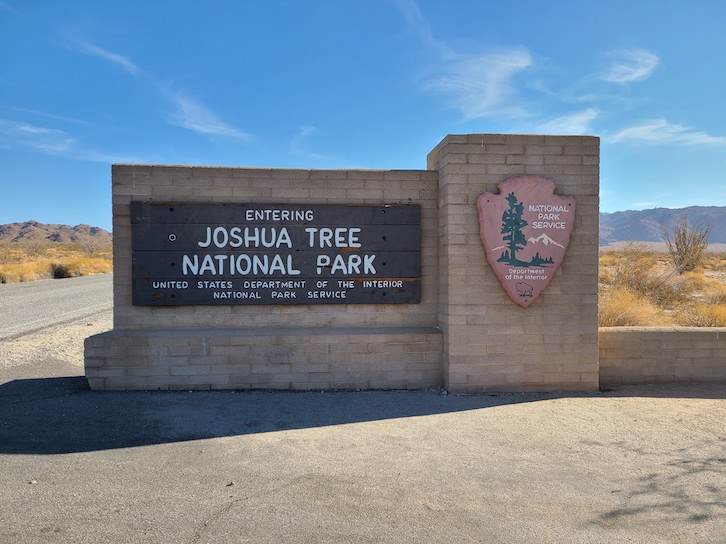
Table of Contents
About Joshua Tree National Park
The story goes that the iconic yucca was named by Mormon pioneers, since the plants’ outstretched branches reminded them of the Biblical character Joshua reaching out to God in prayer. They are protected in this national park as they are a vital part of the Mojave desert ecosystem.
Get Your Travel Goals Newsletter & BONUS Workbook
Afforded national park status in 1994 this area receives just under 2.5 million visitors a year. The southern California landscape has various unique rock formations, desert plant and animal life such as cholla cactus and big horn sheep. Heading here during a March to May window also allows you an opportunity to see beautiful wild flowers. A fall window will give you gentler weather.
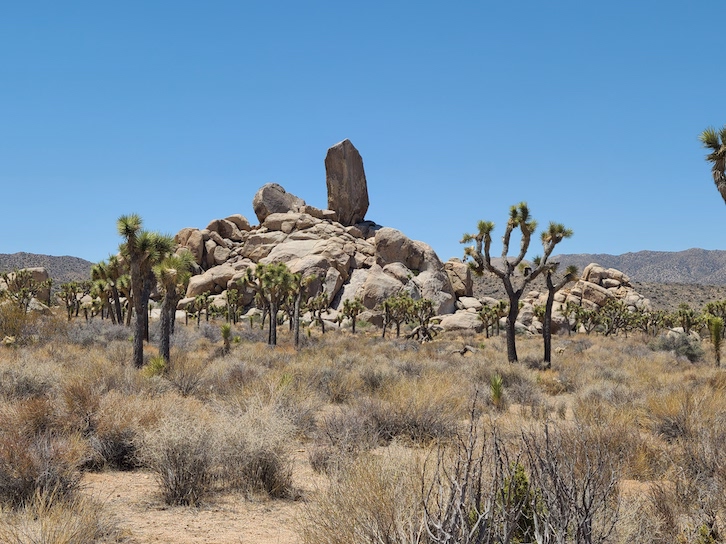
Exploring Joshua Tree National Park – An Itinerary for One Perfect Day
There are three Visitor Centers at the park so no matter where you stay you’re likely to be close to an entrance. We recommend starting at the Cottonwood Springs area just off Hwy 10 and ending at Indian Cove Nature Trail. If you are staying in Indio or Palm Springs Cottonwood is a great entrance choice and this itinerary will get you across the park to appreciate the majority of sites in one full day.
If you are staying in Twentynine Palms then Oasis Visitor Center and the North Entrance Station are your main points of entry. You can drive straight down Park Boulevard to Pinto Basin Road and pick up this itinerary at the Cholla Cactus Gardens.
If you plan to enter the park through Joshua Tree then we suggest you drive east on Hwy 62 first to hike the Indian Cove Nature Trail at sunrise. That will save you the most time in back tracking. You can do the rest of the itinerary from the Joshua Tree entrance station just in reverse order.
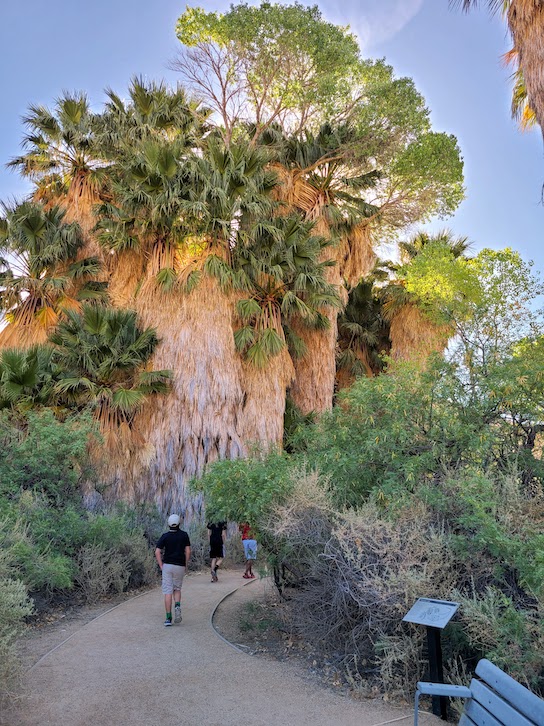
Cottonwood Spring Visitor Center
Staying in Palm Springs puts you the same distance from the Joshua Tree Visitor Center or the Cottonwood Visitor Center. You drive east on Hwy 10 and in just under an hour you’re hiking the Cottonwood Spring trail just south of the Visitor Center.
Get Your Travel Goals Newsletter & BONUS Workbook
From here you can also catch the 3-mile Mastodon Loop Trail or hike the longer 7.5-mile path to the Lost Palms Oasis. The trail to Lost Palms is strenuous so we recommend coming during cooler months to take this.
After exploring the cool oasis of palm trees and hanging out in the hard-to-find shade, head over to the Visitor Center if it’s open to pick up your America the Beautiful pass.

Cholla Cactus Garden
Driving up Pinto Basin Road your next stop is the Cholla Cactus Garden. This is an easy quarter-mile loop through thousands of cholla cacti. This is an excellent spot to take sunrise photos or just enjoy a family-friendly hike through the unique field.

Just make sure if you have little ones you let them know how to stay safe. The cholla look almost fluffy with all their white spines but that is nothing you want to touch!

Arch Rock
Continue your drive along Pinto Basin Road and just past White Tank Campground you’ll see a parking area on the left side of the road. Park here at Twin Tanks and walk across the road to the Arch Rock trail. This is a 1.4-mile loop with a slight elevation gain of 100 ft.
Get Your Travel Goals Newsletter & BONUS Workbook
You get views of unique rock formations and the kids can enjoy a bit of climbing. The Arch Rock looked more like an elephant to me. To take photos you will have to be in front of the arch as there are very limited views from the back.

Split Rock, Skull Rock, and Jumbo Rocks
Just past the Belle campground, you’ll turn left to take Park Boulevard. Each one of the stops along this section of the drive, Split Rock, Skull Rock, and Jumbo Rocks have parking either in lots or along the road.
Split Rock offers a moderate loop hike of 2.5 miles. There is a bathroom in the parking area. Skull Rock has a 1.7-mile trail that also connects to the Jumbo Rocks parking area. If you don’t want to hike the whole trail there is parking along the road right in front of Skull Rock.
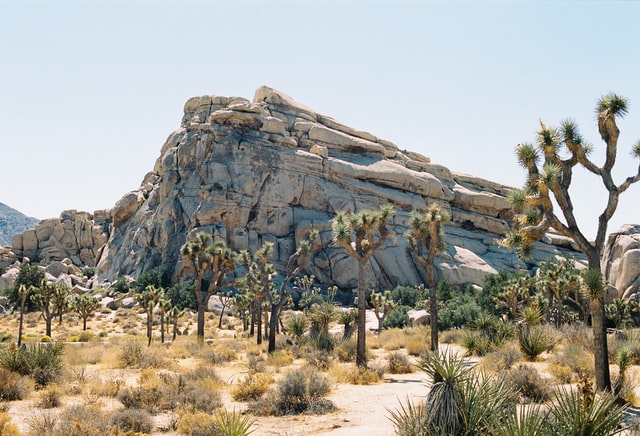
Hall of Horrors
If you want an opportunity for a bit of rock climbing this may be the stop for you. Follow the rock climbers to a narrow stretch opening between boulders. You’ll appreciate the shade! It’s a challenge to find but if you are willing to do a bit of climbing you’ll be rewarded with great views of the surrounding area.
Ryan Ranch
Just after Oyster Bar, you’ll find parking on the left side of the road for Ryan Ranch Trail. There are also bathrooms here. This is where we choose to have lunch. It was still cool and we ate in the shade of our car.
Get Your Travel Goals Newsletter & BONUS Workbook
The trailhead is right next to the parking area. This one-mile trail with a slight elevation gain of 135 feet takes you to the remains of a historic adobe structure. If you are here during cooler months then you can tackle the Ryan Mountain hike. This popular trail gains a strenuous 1,050 ft in elevation and takes you to the summit. Once again we strongly recommend that you save the more strenuous hikes for cooler months.
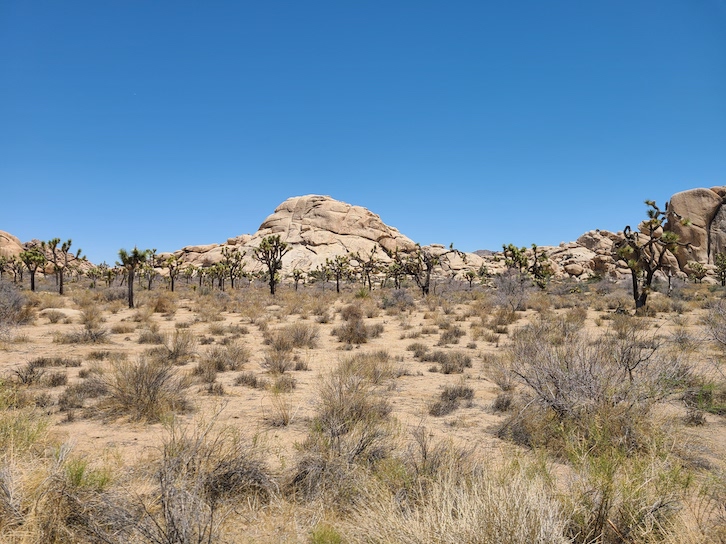
Keys View
Back on the road, you can turn left to drive to Keys View. This is the spot in Joshua Tree to enjoy the sunset. There is a quarter-mile paved path here that affords you views of the surrounding area.
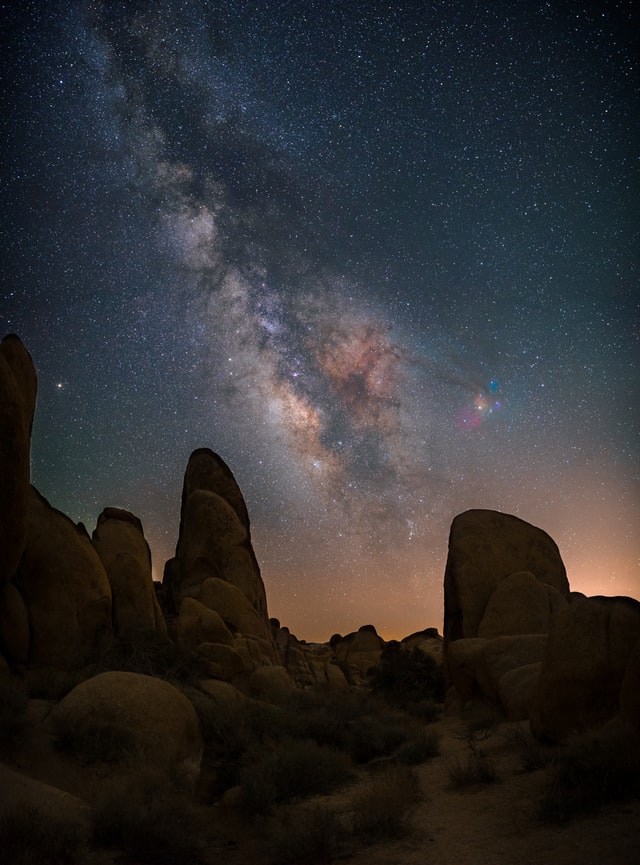
Hidden Valley and Barker Dam
Keep right on Park Boulevard and you’ll see the turn-off for Hidden Valley. There is a picnic area here as well as an easy 1-mile loop trail.
Just past the Hidden Valley campground, you’ll connect with the Barker Dam trail. This 1.1-mile loop trail allows you another chance to explore the area’s pioneer and cattle ranching history.

Indian Cove
Continue your drive on Park Boulevard to the West Entrance station. They were stopping drivers on the way out to have them show their park passes so have yours out and ready. Just past the Joshua Tree Visitor Center, the road intersects with Hwy 62.
Head east on Hwy 62 to Indian Cove Road. Turn right and head past the Ranger Station. The first trailhead you see is along the road and has signage. This is the Indian Cove Boy Scout Trail, not the Indian Cove Nature Trail. Keep driving. Drive past the campground. Follow the road to the right and once you start seeing actual campsites along the road you will know you are getting there.
Get Your Travel Goals Newsletter & BONUS Workbook
You will eventually see signs guiding you toward the nature trail. There is a parking lot at the trailhead as well as restrooms. At the trail head you can either go right or left. Each direction has three or so signs that explain key animal and plant life in the desert that helped the American Indians in this area survive.
This is a fantastic way to wrap up your day in the park. We were alone on the trail except for one jogger (Yes, you read that right. There was someone jogging the nature trail… at the end of May… in 100-degree weather. God bless.)
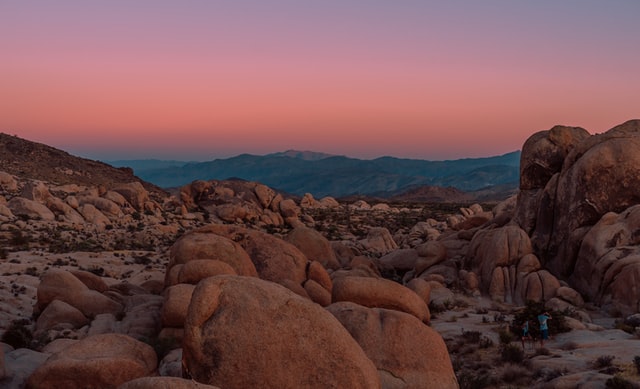
What to Bring
Be prepared for extreme weather at the park. We visited during Memorial Day weekend and it reached 96 by 11 AM. Check the weather before you go to make sure you are taking advantage of the cooler hours. The local weather reports included temperature updates by the hour and were incredibly helpful.
After considering the weather, you’ll need to pack the following:
- Water – planning on being out for the day, then bring at minimum a gallon per person. Take into consideration the difficulty of hikes you want to tackle. If you are going to be very active then consider bringing more.
- Food – there are no restaurants in the park so bring in food for snacks and lunch at the very least. There are numerous dining options outside the park in the surrounding towns.
- Sun Protection – you’ll want a hat, sunscreen and sunglasses to help keep you comfortable and protected in the heat.
- Closed Toe Hiking Shoes – stepping on a stray bit of cactus while wearing sandals is not how anyone wants to spend their time in the park so be sure your feet are protected
- Headlamp – planning to enjoy the night sky, this is a great place to do it! Plan ahead by packing a headlamp with a red light option. This allows you to stay hands free while hiking safely in the dark and you won’t disturb others with glaring lights.
- Camera/smart phone – you will definitely want to take pictures so bring your gear! Also you can download trail maps ahead of time as cell phone reception in some areas may be spotty.
We hope you enjoy your day in Joshua Tree. Whether it’s a camping adventure, scenic drive or two hour hike to the top of Keys View Trail, we can’t wait to hear about what you experienced and how your perfect one-day excursion through Joshua Tree National Park went. What did you see that really stood out on this trip? Was there a tip here that was particularly helpful? Leave us a comment below!
Interested in other desert hikes? We have the answers you need to hike The Valley of Fire.
Interested in another California national park experience? Grab our detailed post on the best things to do while exploring Sequoia and Kings Canyon National Parks. Or travel to nearby Yosemite and explore the icon of the California national park scene.
Enjoy one of California’s least crowded national parks with everything you need to know about exploring Channel Islands National Park.
